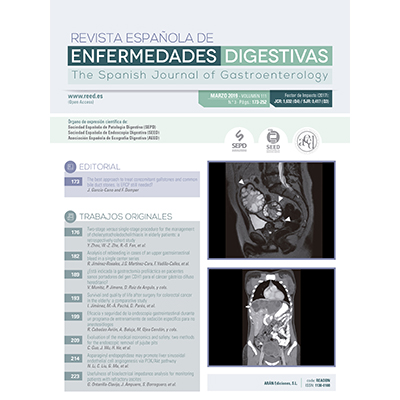Category: News









Sucrase-Isomaltase Deficiency as a Potential Masquerader in Irritable Bowel Syndrome

BACKGROUND:
Patients with irritable bowel syndrome (IBS) frequently have meal-related symptoms and can recognize specific trigger foods. Lactose intolerance is a well-established carbohydrate malabsorption syndrome that causes symptoms similar to IBS such as bloating, abdominal pain, and diarrhea.
However, the prevalence of sucrase-isomaltase deficiency (SID) in this population is poorly defined. SID is a condition in which sucrase-isomaltase, an enzyme produced by brush border of...Читать далее »
The use of serum calprotectin as a biomarker for inflammatory activity in inflammatory bowel disease

INTRODUCTION:
simple, reliable and non-invasive biomarkers are needed to enable the early detection of inflammatory activity for the correct management of inflammatory bowel disease (IBD). One of these biomarkers may be serum calprotectin (SC).
MATERIAL AND METHODS:
a prospective study was performed of patients with IBD due to undergo a colonoscopy as part of the common clinical practice. The study parameters included SC, fecal calprotectin (FC) and conventional blood test parameters....Читать далее »
Non-immunological biomarkers for assessment of villous abnormalities in patients with celiac disease

BACKGROUND:
Demonstration of villous abnormalities is an essential component of diagnosis of celiac disease (CeD) which requires duodenal biopsies. There is a need for non-invasive biomarker(s) which can predict the presence of villous abnormalities.
METHODS:
Levels of plasma citrulline, plasma I-FABP, and serum Reg1α were estimated in treatment naïve patients with CeD and controls. The levels of these biomarkers and their cyclical pattern was validated in a predicted model of...Читать далее »
Dyspnoea and constipation: rare case of large bowel obstruction secondary to an incarcerated Morgagni hernia
Incarcerated diaphragmatic hernias are often challenging to diagnose. Patients often present with non-specific abdominal symptoms, and barring an imaging modality that confirms herniation of intra-abdominal contents, there is no investigation sensitive or specific enough to identify it.
It is a rare cause of mechanical bowel obstruction that clinicians should be aware of. This report describes a case of an 81-year-old man who presented to the emergency department with ongoing dyspnoea...Читать далее »
Clinical features and management of painless biliary type sphincter of Oddi dysfunction

OBJECTIVE:
The objective of this study was to clarify the characteristics and management of painless biliary type sphincter of Oddi dysfunction (SOD).
METHODS:
From June 2002 to July 2018, 12 patients who had recurrent liver dysfunction with a dilated bile duct or acute cholestasis of unknown cause without biliary pain (painless SOD) were included in this study. These patients’ characteristics were compared with those of 36 patients with biliary type SOD based on the...Читать далее »
Meta-analysis of Histological Margin Positivity in the Prediction of Recurrence After Crohn’sResection

BACKGROUND:
Despite significant advances in the medical management of Crohn’s disease, many patients will require intestinal resection during their lifetime. It is disappointing that many will also develop disease recurrence.
OBJECTIVES:
The current study utilizes meta-analytical techniques to determine the effect of positive histological margins at the time of index resection on disease recurrence.
DATA SOURCES:
Embase, Medline, PubMed, PubMed Central, and Cochrane databases were...Читать далее »
Clinical response to fecal microbiota transplantation in patients with diarrhea-predominant irritable bowel syndrome is associated with normalization of fecal microbiota composition and short-chain fatty acid levels

Objectives:
Irritable bowel syndrome (IBS) may be associated with disturbances in gut microbiota composition and functions. We recently performed a study of fecal microbiota transplantation (FMT) in diarrhea-predominant IBS (IBS-D) and found that IBS symptoms improved and the gut microbiota profile changed following FMT.
We now aimed to explore the effects of FMT on the gut microenvironment in further detail by using 16S rRNA sequencing for more extended microbiota profiling and analyzing...Читать далее »
Prospective study evaluating immune-mediated mechanisms and predisposing factors underlying persistent postinfectious abdominal complaints

BACKGROUND:
The role of persistent immune activation in postinfectious irritable bowel syndrome (PI-IBS) remains controversial. Here, we prospectively studied healthy subjects traveling to destinations with a high-risk to develop infectious gastroenteritis (IGE) in order to identify immune-mediated mechanisms and risk factors of PI-IBS.
METHODS:
One hundred and one travelers were asked to complete questionnaires on psychological profile and gastrointestinal (GI) symptoms before travel,...Читать далее »
Starch with high resistance to amylase to reduce stool output in people with short bowel syndrome: an experimental study

ANNOTATION
Short bowel syndrome (SBS) is defined as having less than 200 cm of functional small intestine. It is difficult to cope with malabsorption diarrhea and dehydration, despite drug therapy and dietary manipulations.
Evidence suggests that adding high-amylose starch (HARS) to your diet can reduce diarrhea for a number of reasons, including gastroenteritis. HARS is expected to reduce stool production through the production of short chain fatty acids and, as a result,...Читать далее »
How to deal with severe acute pancreatitis in seriously ill patients

PURPOSE OF THE REVIEW:
A review of recent literature on the management of severe acute pancreatitis (SAP) admitted to ICU.
LATEST FINDINGS:
SAP is a devastating disease associated with high morbidity and mortality. Recent data confirm adequate risk assessment and prediction of severity (including monitoring of intra-abdominal pressure), individual fluid administration in favor of balanced crystalloids, refusal of prophylactic antibiotic therapy, and early detection and treatment...Читать далее »
